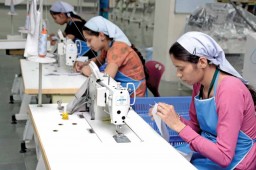
Driving Industry Towards Sustainable Human Capital Advancement (DISHA), which was launched with much fanfare last year has hit a roadblock with the industry asking some tough questions. The most disturbing fact is that the industry, which was supposed to be the beneficiaries of the scheme are not convinced that the project will give them value and that at the end of the day it is not going to reduce the burden of audits, which is their biggest need. Apparel Online has been keeping a close watch on the progress of the project and has attended many of the open house sessions, but even we cannot deny the changing directions of the project from one meeting to another.
Initiated with the aim to encourage members to follow better social practices, which would give them a competitive edge in the global market where social compliance is increasingly becoming an important buying decision, AEPC launched Disha officially in December 2011, though preliminary meetings and informal talks with stakeholders were already in progress. The object as defined in the introduction papers was to undertake root cause analysis and impart guidance by a team of experts as part of the capacity building programme.
The AEPC held that a toolkit will be prepared based on the ‘Common Compliance Code’ by which the enrolled units will undergo an orientation and training program. Following which a remediation plan would be introduced and after monitoring the improvement, necessary certifications will be given. The AEPC also indicated that international agencies will be empanelled to audit the program. Very much upbeat of the program the then Chairman of AEPC, Premal Udani declared, “Disha’ will not only give an opportunity to the industry to negate international claims against child labour promotion in the garment industry, but will also help to improve the overall image of the industry on the global front and not the least, to win more international businesses.
However, after six months only 155 exporters have registered and though the focus was to be on small and medium sized exporters who are not in the audit net or are finding it difficult to clear audits due to lack of understanding of the requirement and action needed to be taken, many of those registered are big exporters who are well versed in the audit process and are already compliant by international standards… The most common question being asked is why are big exporters enrolling when they clearly have nothing to gain.
Many in the industry feel that the bigger exporters are joining only to show numbers, as smaller exporters have not reacted as positively as anticipated. Not wanting to be named, an exporter said that he received a call from one of his influential buying offices to enroll, living him with little choice. The smaller exporters are disillusioned as the whole concept is diluted if companies which are already compliant are being graded and evaluated with the same yardstick as they are. The concern is simple… has the basic agenda changed?
Another major concern that is surfacing is that Disha is no longer talking about a common compliance code though all its promotional material claim that the objective was to create a common code that would form the bases of all the activities… If the program no longer promises a common code for the garment industry then what is the bases of evaluation… is it international norms, Indian laws or buyer codes, the confusion still remains. The contention of the industry is that if the law of the land is the base then many of the buyer codes are not fulfilled and then how will the project aid business.
Further, if we follow the law of the land then there is already systems and agencies in place to ensure that these laws are properly followed… then why do we need Disha to look into this area. Is not the Labour Ministry responsible for enforcement of labour laws?
In its many open house sessions the project leaders claimed that the program is not ‘audit oriented’, but is about hand holding to uplift working environment and infrastructural compliances of the industry… yet how will evaluations happen without an ‘audit’. The way the results are projected may be different… say instead of pass/fail, it may be coded to signify stages of compliance, but the bottom line is that factories need to be audited and continually monitored for determining the stage of compliance, self assessment cannot get foolproof results, so how is it any different than working with the commercial audit agencies. The industry is asking why the need of Disha at all, if they will work on similar lines as the audit agencies. Despite efforts the critical difference between commercial audit and Disha assessment has not been able to be communicated with conviction.
Another worrying part is the lack of answers regarding the future course of action… What will happen after a year… Will companies again have to register or is there a continuity provision… is Disha only about educating and creating awareness or will they take the next step and ensure that factories who have shown faith in them are sustainably compliant. Will the buyers accept Disha certifications as creditable, is another key concern.
The Disha team has not been able to convincingly communicate that buyers are with the project. In fact one buyer has asked how the project will satisfy different brands from different countries with one yardstick when many international attempts to create a common code have failed. Though many buyers have participated in stakeholder meetings, the apprehensions remains on where the focus area is… social, environment or technical compliances. Though the AEPC claims that the program is not about workers, but factory compliances; Disha decoded clearly says ‘Driving Industry Towards Sustainable Human Capital Advancement’, which implies that the focus is on people. Where is the discrepancy between the intent and the obvious?
Many NGOs and labour organizations are not sure how the workers will be handled and they are pushing for a clearer understanding of the agenda. No one is sure how the ‘right of association’ will be interpreted and the concerns of the NGOs could be a major hurdle in successful implementation.
Some have questioned: How competent are the agencies that have been taken on board for implementing the project and if they are already into the business why not associate with them directly?
In fact, many in the industry have even gone ahead to question the ‘intent’ of the project…If the project cannot promise us fewer audits, sustained compliance and long term credibility why should we enroll. The project may have the backing of the Ministry of Textiles, but the module is aimed to be a profit centre for the AEPC as the nominal fees of Rs. 25,000 being charged today is already admitted to be a subsidized rate, which will be reviewed in time. Exporters are increasingly saying that if I have to pay then I should align with a global audit agency, the certificate of which will certainly ensure compliance clearance. Currently the Ministry of Textiles is funding 75 per cent of the project cost.
Today the Disha project seems to be directionless with more questions than answers… in retrospect it looks as if the project which is being claimed as a national program lacks the conviction that can satisfy concerns from different stakeholders. How can the project move ahead on in the midst of such uncertainties…






